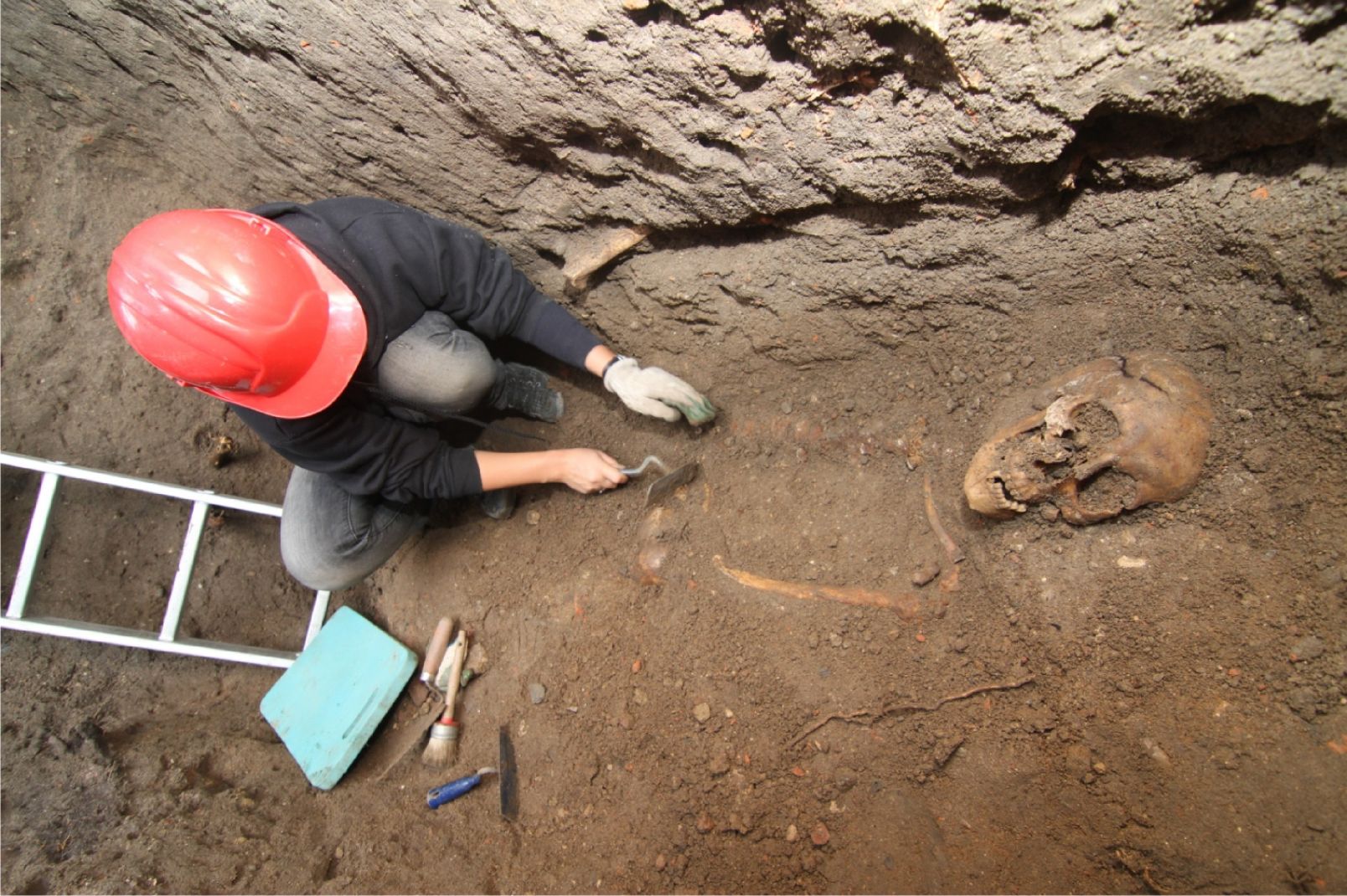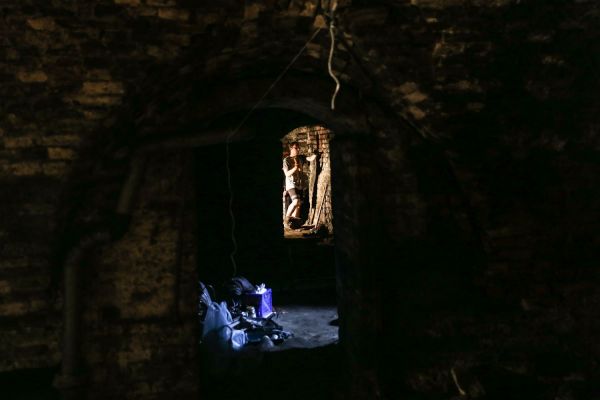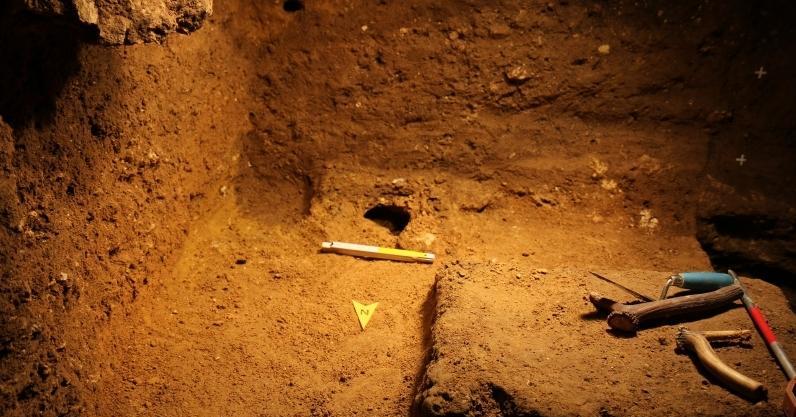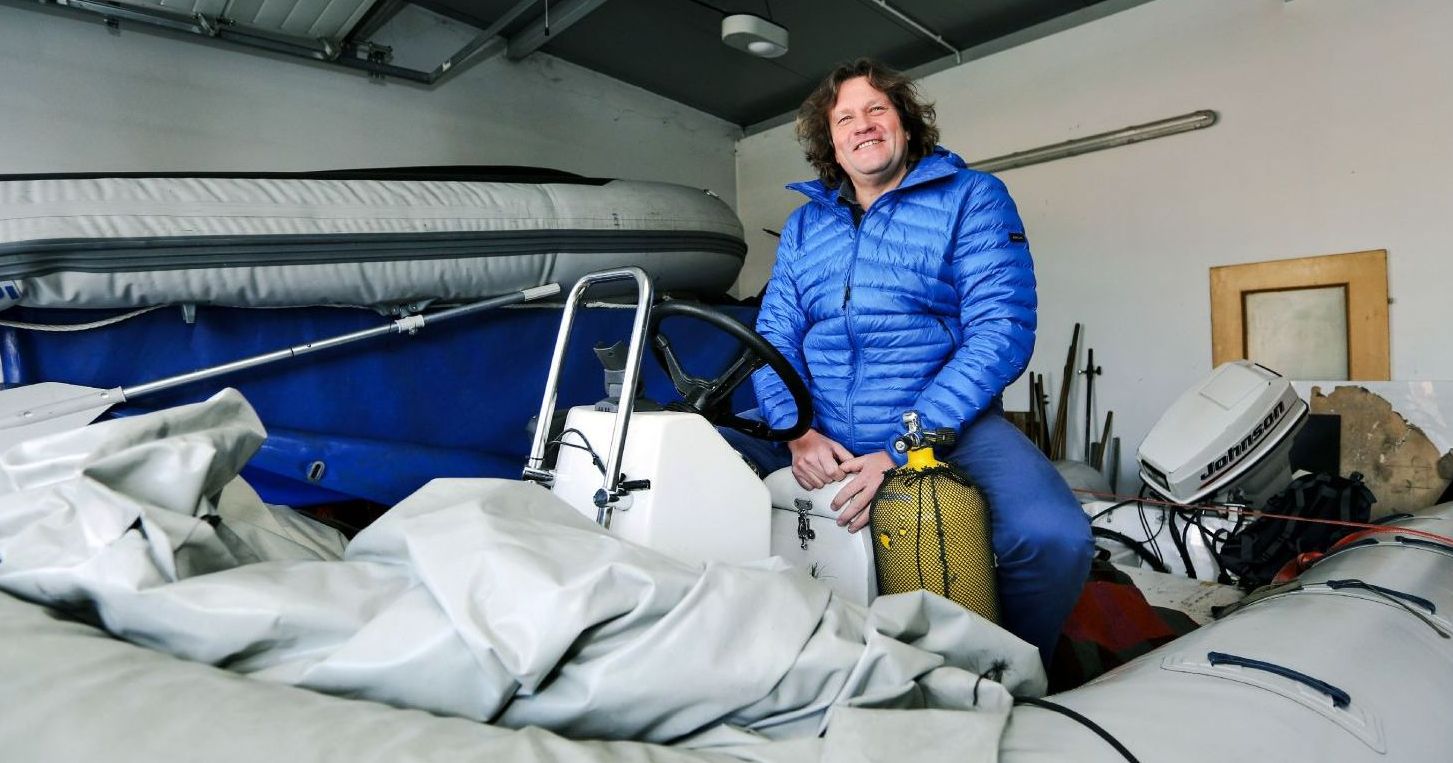Secrets of Saint James’s Church
For the first time in history, archaeologists from NCU began digging works inside St. James's Church in Toruń. They discovered that the space beneath the floor used as a burial place of the inhabitants was densely filled with burial chambers which reach as deep as the fundaments of the walls and the tower of the temple.
The works inside were ending eight seasons of research inside the temple and its premises. The archaeologists especially wanted to see the underground joint between the corpus of the central nave and the sanctuary. Due to the fact that the floor there had already been replaced, they could not make the digging point there. They were allowed to make only two examinations: in the western part of the building, at the joint of the northern nave and the western church porch, as well as at the joint between the northern tower and the church porch.
We have decided that the fundaments at the tower were laid with the use of a slightly different technique from the one applied at the sanctuary. Yet, it is also made of stone, with the mortar, and from large rocks – says Krystyna Sulkowska-Tuszyńska, dr. habil., NCU professor from the Institute of Archaeology. – It might have been constructed by a different construction lodge. It was also erected in a different period of time. At the beginning of my research in the church, I assumed that as every similar object in Christian Europe this could have been a graveyard as well. It was typical that during digging works for burial the floors would be destroyed everywhere but, in the corners, at the walls and pillars. These were usually not even approached, therefore I expected to uncover the floors in situ, as it is estimated that a floor in temples was replaced every 100 years. This was proved in our research in the Romanesque basilica in Strzelno. I expected to find in the corners a few relics of floors – five or maybe six. We found none as burial chambers had been dug up to the corners of the western and norther tower, four levels; three with coffins, the oldest one without any coffin.
The Surface under the church floor was used to every inch. At the tower, NCU scientists came across a very significant grave. The coffin was well preserved, with a large black painted cross on the lid, almost the size of the coffin. Inside were the remains of a male, which are now being examined by Tomasz Kozłowski, dr. habil, NCU professor. What else was found were scraps of silk robes, and on the chest a silk scapular. Although scapular usually contained medallions, this one was empty. On its surface there was a small five-cm high cross embroidery.
Due to the diggings inside the church, the scientist could evaluate the lower parts of the western wall, which until then had been covered by the floor as the level of the church was rising for years. The newest floor lies about 70 cm above the initial utility level. These were the last archaeological works in this place for at least 100 years. The church has a new floor, and by the next decoration works, no one will ever allow to have it dismantled.
At the onset of the works in St. James's Church, the archaeologist set themselves three main cognitive goals. They wanted to establish when the construction works of the building in the New Town started, to examine the burial places around the temple, and due to the excavations of the graveyard to learn about the inhabitants of the New Town as much as it is possible through anthropological research of the skeleton and the items found in the former necropolis.
Dating
Historians confirmed the discoveries of the archaeologists that the beginnings of settlements in this place were closely linked to the town location and they denied any possibility of any other buildings being erected in this place before. Neither did they find any traces of primaeval settlement. As for the beginning of St. James's Church, all might have seemed clear as, on the walls of the temple, there exists an inscription which reads that in 1309, Herman, Chełmiński bishop set a cornerstone for the erection of the church. This could have meant that since the location of the New Town in Toruń, between 1264 and 1309, the eastern part of the town had no church. This seems logical as the plot of the land nearby went to the Dominican Order, whose monks were already building Saint Nicolas's Church. There were also churches in the Old Town, with a distance of a 10- or 15-minute walk from the New Town. Everything here is correct, but this is the contemporary way of thinking – says prof. Sulkowska-Tuszyńska. – Still, a new located Christian town in Christian Europe wanted to have its own church. It was not only the matter of a place for prayers, but most of all some symbolism: in this way Teutonic Knights Order marked their realms. On the basis of observations of the relation of the fundaments of the presbytery, the setting of the walls and supporting abamurus, as well as absolute dating of the bricks (TL, OSL) I am absolutely certain that in the 13th century in the New Town of Toruń a church was being erected and it was being built in the place od today's St. James's Church, and that after 1309 a new presbytery was being constructed on the same fundaments, again with the use of bricks.
The first brick church was built in the shape and size of today's presbytery. This has been proved by the layer of demolition bricks and their layout on the stone fundament, which has been found by archaeologist. Builders used the old fundament to support new abamurus, now set diagonally, in accordance to the rhythm of the new church; it was also a support for a small staircase tower at the joint of the naves of the presbytery. The assessment of the relation between the nave corpus and the new presbytery was not possible due to the fact that no research inside the church was allowed.

Both archaeologist and historians have no doubt that the erection of the first church was not possible before the location of the town. For certain, however, it was being built after 1264 and before 1309. – Even though we have not found stone with a carved cross, which was typical for cornerstones, I do assume that also under the firs church, in the 13th century, before the construction works started, a similar stone was placed – claims prof. Sulkowska-Tuszyńska. – It is yet necessary to remember that the beginning of the 14th century was the time when Teutonic Knights were buoyantly developing their state: they erected the castle of Malbork, occupied the city of Gdańsk, and wanted to demonstrate their power. I suppose that the decision to rebuilt the church was made to make it higher, more magnificent with a spire visible from a far distance. It was to shine and confirm the power of the Teutonic Knights Order. The year of 1309 in the inscription is the year of setting the cornerstone, but not necessarily the year of beginning the construction of the church. After a precise analysis, the researchers claim that the application of Past Perfectum tense in the inscription suggests that the erection works began after 1311, which was the year of death of bishop Herman.
Burial of bodies
In the middle of the 14th century, Teutonic Knights handed the patronage over the church down to the Female Cistercian Order. The nuns were to pray in it, take care of it and offer aid in the almshouse nearby. At the same time, the parochial graveyard was still functioning. Once the Reformation started and king Sigmund August allowed Martin Luther's ideas to spread, these new ways of thinking very quickly found a good ground in Hanseatic towns, where protestants were taking over catholic churches. Toruń became mostly protestant; in 1557 Catholics also lost St. James' Church. A funeral rite appeared on the cemetery. This was noticed by researchers, who recognized the necropolis. Most probably, the cemetery was used for parochial funerals. Written sources lead to a conclusion that the almshouse had its own plot nearby, at the neighboring St. Catherine's Church. In those days, there stood a chapel which was guarded by Cistercian nuns, the same as those who were taking care of the hospital. Scientist suppose that it could have been a burial place for the patients of the hospital and for the poor.
It is absolutely certain that they were not buried on the premises of the hospital as we did our excavations there – assures prof. Sulkowska-Tuszyńska. – This we can absolutely exclude, yet we do not know if in a certain period of time, the dead were not buried for some reason at the hospital wall, along today's Hospital Street (Szpitalna Street). Those dead people were nameless, and this we cannot recognize any further. Due to the research conducted by Jarosław Bednarek, Ph.D., we know that in certain parts of the graveyard, between the church and the monastery at the south of the church more people buried were those with various bone fractures and physical injuries. This could be interpreted as graves of manual laborers, yet it does not give any ground to assume that such plots were designated.
The area of the cemetery around St. James's Church was used to the full. The fewest burial places – six layers – were found by the archaeologists near the buildings, where no more dead corpses could be “packed". In the places where conditions were more agreeable, dead corpses were buried on as many as 15 layers. The scientists made deep digging works, as deep as 4,3 meters, but as in some places at the depth of 2,5 m the so called calca layer starts (mostly sand and clay). This layer had not been touched by a man and shows no traces of human interference. Quick calculations show that in the most used places, the vertical distance between particular burial layers is only a few centimeters. – In some places, for instance in the presbytery, which is close to the altar and the heart of the temple (those alive wanted to have their closest ones buried as near the sacrum and the relics hidden in the altar as possible) the density of the buried bodies is so high horizontally that children's bodies were placed on adult ones', and some of the dead were even placed on the side of their bodies to pack as many of them as possible – says the archaeologist from Toruń. – Such density was possible as in most cases the dead were buried without coffins. In the lower parts of the graveyard this was almost a rule. A few more coffins were placed higher. In a few cases, however, especially those of graves from the 15th and 16th centuries we found biers, which were pallets on which a dead bod was laid and then put into the burial chamber. What is a curiosity is the fact that the pallets did not fit the height of the corpses. They were usually shorter, from head down to half the length of this only to make sure that the body did not fall down.

The scientists assume that parishioners were buried at St. James's Church. They did not find any traces and thus on no grounds can they claim that a monastic plot was designed. – We had no possibility to penetrate most of the sacral space or the crypt or the presbytery, where I am sure the graves of clergymen are – assures prof. Sulkowska-Tuszyńska. – This is another grand task which is waiting for anthropologists, archaeologists and historians of church, and the entrance to the crypt does not require any infraction of the structure of the walls or their layers. I do assume that we will find their burial chambers of the youngest horizon as the older ones must have been removed and transferred into an ossuary, which was a mass grave.
Watching
Due to the examination of the graveyard, the scientists were able to see to the material culture of former inhabitants of Toruń. It was a very small and narrow piece, as it was watched through the prism of artefacts which had been lost on the grounds of the necropolis while digging the graves or visiting dead relatives. The objects were scattered as graveyards in the past were not as clean as today. Sometimes, they served as a form of a landfill site whereas sometimes as a venue of various meetings. The archaeologists divided them into different groups, beginning from ceramic vessels, through objects made of metal, bone and finally of glass. Ceramic objects were usually fittings used for roof constructions, floor tiles, the most beautiful of which were those a motif of a lily flower, bricks and so-called vessel ceramics, including pottery from the turn of the 13th and 14th centuries until the 20th century. Very beautiful is stoneware which was imported mainly from Rhineland to almost every Hanseatic town. There are also modern homogenous pipes, which may not have been lost, but definitely had not been purposely left in the graves. They have long stems and, in most cases come from Gouda, 17th century.
When it comes to glass objects, these are mostly bottles from the 18th and 19th centuries, some with German inscriptions from the times of Prussian Partition. The researchers also discovered that the bottles had been manufactured in various glassworks in the central Pomerania.
This we know due to special seals pressed on the bottles, which in the period from the 17th to 19th century were commonly used for storing and transporting liquids – says prof. Sulkowska-Tuszyńska. The glassware has unveiled other curiosities, for instance the bottoms of glasses dating back the 15th and 16th centuries imported from Saxony and Brandenburg, and very popular in the 18th century goblets in the shape of capsized bell. They could have been vessels used for drinking but also containers for olive oil for lighting. Therefore, there could have plenty of them in the area of sacrum, especially along the walls.
The archaeologist found 93 coins. Almost half of them comes from the interior of the church, from the digging under the tower. As few as 12 are Medieval coins, 11 of which are brakteats including 10 Teutonic and silver. One dates back the turn of the 13th and 14th centuries, the rest of them date back the years between 1317 and 1415. Under the ground, there also laid a coin from the times of August Jagiellonczyk from the year 1502.Among the modern coins there are mostly 17th century boratynkas (equivalent of pennies) from the period of John Kazimir. Almost all of them are copper. There were also a lot of coins from the times of Swedish occupation in the first half of the 17th century, Prussian Partition, few from t Russian Partition, and a lot of Prussian pfennigs from the turn of the 19th and 20th centuries. The youngest pfennig coin was minted in Berlin, in 1906.

Among other metal objects, there is a lot of jewellery, ornamental badges, probably used for leather belts. There are also small bone and metal objects, sometimes openwork, some with traces of nailing, which may have decorated tiny reliquaries; a few of them are gold coated. There are also belt and shoe buckles, which may indirectly indicate that the dead were not only buried in winding sheets, but also in clothes. There are very few elements which can be related to coffins. Only in a few places, did the scientists come across very badly preserved iron handles, coffin pivots, which had sometimes been used to decorate the coffin or to pivot the name of the dead and their date of death.
A large number of metal relics found on the graveyard are funeral coronets. – On catholic cemeteries, which are well known to archaeologists and have been thoroughly examined, this funeral ceremony did not exist – assures prof. Sulkowska-Tuszyńska. – In my opinion, this was a custom introduced by protestants. After they left St. James's Church and moved to Saint Trinity Church on New Town Square, the custom remained, therefore we found funeral wreaths in burial even in the layers dating back the 18th century. Funeral wreaths are a magnificent basis for further study and research of funeral customs and traditions. The wreaths were most probably laid only on the innocent: children, bachelors, alleged nuns devoted to God.
In most cases, they were absolutely used to decorate the head and only one was laid on – reveals prof. Sulkowska-Tuszyńska. Yet, we came across “princess" as students named her. On her grave, we found seven funeral wreaths. A young 13-year-old girl buried in a very symbolic place, before the entrance to the side portal of presbytery, had a wreath on her head, a huge wreath on her chest, and ever bigger ones on her hips, knees and feet.
On the cemetery of St. James's Church, three types of funeral wreaths were used: simply made of a few plaited wires, on a laith which served as a supporting construction, and a huge number of sequins. Most wreath had live flowers plaited in if the nature allowed, the flowers were real, yet in winter they were dried, made of linen or silk stretched over a wire construction. Scientists claim that in Toruń there must have been a lot of workshops specializing in funeral wreath production.

Among the findings, jewellery constitutes a very decent collection. This is usually rings made of bands. – At St. Valentin`s Chapel, in the southern part of the church and on the 17th level, we found on a had of a young girl a silver ring consisting of three plaited thin rings – says prof. Sulkowska-Tuszyńska. – The widest band is additionally widened at the front and in the place for the jewel basket, the décor of the ring. This was an engagement ring, a gift for the beloved one. Perhaps one day it will appear in a catalogue of the findings from this place and one of the jewelers in Toruń will get inspired and make a similar one.
At the easter side of the church, archaeologist dug out a beautiful stone decorated sliver brooch in the shape of a rosette. I was not related to any funeral. It might have belonged to a rich patrician of the town as the portrait gallery of rich nobles of Toruń indicates that they often wore such brooches under their collars.
During the excavation works, the researchers also found the oldest monument of the New Town of Toruń. Related to the first phase of the functioning of the church or the beginning of the second, it is a stone baptismal bowl, which was thrown away in the 19th century as it had cracked or chopped off. We are convinced that it is a bowl in which the first inhabitants of Toruń between the second half of the 13th century and the third quarter of the 14th century were baptized. The bowl is hemispherical inside and octagonal on its outer surface, just like baptisteries which used to be octagonal – explains prof. Sulkowska-Tuszyńska. – It is well polished inside. On the outside it was decorated with eight arcades, below each of which there was a lion. Three lions have survived, and each is clearly in the walking posture with one paw raised. This is a symbol of chasing the evil off the sacred water. In the Middle Ages, sacred water was often an object of theft, but it was also believed that the devil and evil forces crawled to the sacred water to profane it. This bowl has already undergone conservation works and it was exhibited in the Regional Museum of Toruń at the exhibition devoted to the 750th anniversary of the location of New town of Toruń
At the beginning of 2022 at the latest, the church will have its monography issued under the authorship of prof. Sulkowska-Tuszyńska. This will be a recap of the research works carried out within the grant of the program Protection of Archaeological Monuments of Ministry of Culture and National Heritage. Yet, in autumn 2021, an archaeological guidebook “History of St. James's Church. History taken from under the ground" will be published. St. James's Expedition has been for years sharing its findings in the blog: https://archeologiajakub.wordpress.com/ The discovery of various mysteries of the church has been made possible due to multiple specialists and scientists of Toruń: archaeologist, physicists, chemists, and biologists, but also the scientists of Warsaw University, all of whom with utmost care and dedication have contributed to the research.
 NCU News
NCU News







 Humanities and arts
Humanities and arts
 Humanities and arts
Humanities and arts
 Humanities and arts
Humanities and arts

